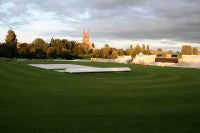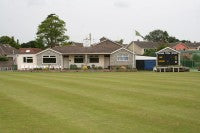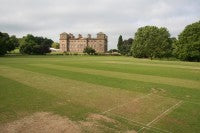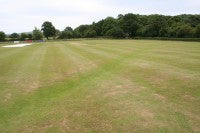Cricket Outfields Maintenance
 In the maintenance of a cricket outfield the success of such work is influenced by whether the site is to be used solely for cricket or for any other winter sport. It would be preferred though if Hockey or Lacrosse was to be played as these sports tend to be less stressful on the grass and ground conditions.
In the maintenance of a cricket outfield the success of such work is influenced by whether the site is to be used solely for cricket or for any other winter sport. It would be preferred though if Hockey or Lacrosse was to be played as these sports tend to be less stressful on the grass and ground conditions.
Alas though, hockey is now deemed to be an astro- turf sport and long gone are the grass pitch's we knew in the past. However, if football or rugby is the preferred sport then a different strategy has to be employed.
LEVELS
Many cricket clubs nowadays possess poor levels of outfields as a result of having originally being constructed from existing farm land or land left fallow. Where the problem is severe, i.e. where the topography is very undulating, it can lead to varying depths of topsoil existing over high & low spots which in turn will effect grass cover and create wet hot spots.
The only way that this problem can be over come is to carry out large scale re- grading and levelling. This can be very costly and involves re-grading and levelling the topsoil. The installation of a drainage system would also be very beneficial s this will remove excess water from the site. This work should only be undertaken by an approved contractor.
 Where the undulations are not to severe and there is a good depth of topsoil, then it is more preferable to remove the topsoil, grade the subsoil's to the required levels and replace or introduce new top soils compatible to the ground conditions. Where isolated undulations occur much smaller scales of work could be under taken to overcome the problem.
Where the undulations are not to severe and there is a good depth of topsoil, then it is more preferable to remove the topsoil, grade the subsoil's to the required levels and replace or introduce new top soils compatible to the ground conditions. Where isolated undulations occur much smaller scales of work could be under taken to overcome the problem.
To do this strip away the turf, adjust the underlying levels and replace the turf. The ideal cricket outfield should be firm, fast, true and present no hazards to any player as a result of a ball popping up from an uneven surface.
If the outfield is solely used for cricket then a sward composed of fine turf cultivars such as Chewing fescue (FESTUCA rubra commutata), Slender creeping red fescue (FESTUCA rubra ssp. litoralis) and Brown top Bents (Agrostis tenuis) with an over sowing rate of 20-30 g/m2 are more desired as these species are more tolerant to drought and can be mowed as short as 7-10 mm providing for a fast smoother surface.
Where the outfield is used for more vigorous sports such as rugby or football then the sward composition should favour a mix of dwarf perennial Rye grass (Lolium perenne) over sown at 25 g/m2. As the "close season" is relatively short, (6-8 weeks), and with moisture levels very low, it is crucial to select cultivars that will give rapid establishment and exhibit the wear tolerance that is required by such sports. High quality perennial rye grasses will give the best results not only for league clubs but also for local clubs and public pitches alike.
MAINTENANCE
 If regular maintenance is not carried out then a cricket outfield can quickly become soft and spongy, as a layer of fibrous thatch develops at the base of the sward. This problem is most particular where fine leafed grasses dominate and where regular aeration has been neglected. Scarification of the outfield is vitally important to reduce the effect of thatch build up. Scarifying at the start of the season will prove highly beneficial in combating thatch. This operation will physically rip out and remove any straggly and procumbent growth.
If regular maintenance is not carried out then a cricket outfield can quickly become soft and spongy, as a layer of fibrous thatch develops at the base of the sward. This problem is most particular where fine leafed grasses dominate and where regular aeration has been neglected. Scarification of the outfield is vitally important to reduce the effect of thatch build up. Scarifying at the start of the season will prove highly beneficial in combating thatch. This operation will physically rip out and remove any straggly and procumbent growth.
Where a thatch problem has developed, a deeper setting should be adopted. Ideally a tractor mounted rotary unit with collecting facility should be used as this will remove a large majority of material in a single pass. If this is not available then a pedestrian unit can be perfectly adequate if used on the area immediately behind the cricket table. A tractor mounted rake or short toothed harrow will also suffice.
Where the problem of thatch is particularly servre then a more drastic approach is required. This will incorporate the use of hollow tinning, the physical removal of cores containing thatch. The cores should then be collected up and disposed of or recycled as compost. A dressing of medium fine sands worked into the profile will also help to break down any thatch build up at the base of the sward. This will also assist in air movement and nutrients being made available to the plants root system and promote a healthier sward.
Deep seated compaction can also lead to drainage as well as thatch problems. If this is the case then the only remedy is to carry out deep solid tine aeration by use of a Verti- Drainer capable of penetrating to a depth of 750 -800 mm with 25 mm tines.
This will create fissure breaks in the underlying soils and allow water movement through the profile. Further deep aeration should follow during the winter months, if ground conditions warrants with the use of slit tines, penetrating to a depth of 100 - 150 mm or an Earth quaking imnant. This too will improve root structure as the grasses search for the pore spaces being made available.
Other main concerns where dual usage is a problem is the renovation of worn area's through the short period at the end of the winter season such as, football goal mouths, centre circles and bare area's caused by scrimmaging. The work required here would be to harrow or rake over the worn and bare areas to reinstate the levels and create a seed bed. Over seed the area with a perennial ryegrass and where possible top dress to cover the seed, a pre seed fertiliser may be required in the event of larger area's of recovery.
Irrigate as required to establish early germination to prevent the area being taken over by weeds. During mild or damp conditions regular brushing of the out field willreduce the impact of disease developing such as Red thread or Fusarium Where worm casting, moss colonisation or an attack of disease become noticeable an appropriate control method should be adopted with a person holding the necessary qualification certification.
FERTILISATION
If the outfield is used only for cricket, and supports swords dominated by fine leafed fescues & bent grasses, then the need for fertilisation is greatly reduced as these grasses thrive in low fertility conditions. Further more a faster growth rate would require more frequent mowing and adds to the maintenance costs. To be exact on the fertility rates can be extremely difficult, as this depends on the inherent fertility of the soils and intensity of wear & tear. An application of an early spring and summer fertiliser when the grasses are especially weak consisting of 20:5:5 granular at the rate of 190-250 kg per hectare will stimulate and encourage early growth.
pH TESTING
It is important to test the pH of your soil to ensure the acidity levels are correct. Soil pH may vary from area to area which you intend to plant or amend; therefore it is important that you take a number of samples for soil analysis. pH is measured from1-14, 1 being the most acidic, 14 the most alkaline. Most plants have a reasonable wide tolerance of at least 1pH point and will be comfortable with a pH of around 6.5. pH can contribute to the build up of fibre, with acidic conditions favouring an increasingly fibrous surface. After having a soil analysis taken of the outfield and if results show a high rate of acidity, <5.0, then careful adjustments need to be made to increase the alkalinity through your fertilising programmes. Annual applications of ground limestone (carbonate of lime) could be considered in the early autumn or winter, allowing it to be washed into the soil following a programme of aeration.
To increase soil alkalinities add ground limestone using the table below:
| Soil type | 6.0-6.5 | 5.5-6.5 | 5.0-6.5 | 4.5-6.5 |
| Sand | 1.5 (1338) | 2.5 (2231) | 4.5 (4015) | 6.5 (5760) |
| Loam | 2.0 (1784) | 4.0 (3569) | 6.5 (5800) | 10.0 (8922) |
| Clay | 2.5 (2231) | 5.0 (4461) | 8.5 (7584) | 12.5 (11153) |
MOWING
 If the existing levels are acceptable, not too undulating, then mowing should be carried out throughout the growing season on a weekly basis, two to three times if playing a high standard of cricket and more frequently for first class match's. In ideal situations the use of a ride on cylinder box mower with a cut width of 36-48 in with all resulting clipping being boxed off will help maintain a fast smooth surface and aid presentation.
If the existing levels are acceptable, not too undulating, then mowing should be carried out throughout the growing season on a weekly basis, two to three times if playing a high standard of cricket and more frequently for first class match's. In ideal situations the use of a ride on cylinder box mower with a cut width of 36-48 in with all resulting clipping being boxed off will help maintain a fast smooth surface and aid presentation.
The mower (or cylinder) should be set between 7-15 mm, resist scalping as this in turn can create stress on the grasses and encourage disease.
Where time is of the essence then trailed gangs or the use of a tractor mounted set of hydraulic gangs would be very beneficial. These have a distinct advantage as the clippings generated by this operation are returned back to the turf. Any losses of nutrients are limited as everything is recycled resulting in less fertiliser being applied. The only down side to this operation is the trailed or mounted gangs do not have the capacity to firm the surface as a ride on mower would have and the tractor wheel markings would be more noticeable during times of inclement weather. Mowing however should be carried out at regular intervals, with the frequency being reduced during the winter months and only carried out during active growth.
Where the outfield has adopted a dual use purpose i.e. Football or Rugby then the mowing regimes would have to be tailored to the resulting sport. The height of cut will vary between 25-35 mm for football & 50 -75 mm for rugby. This can lead to problems with mowing heights during the early summer months however, as the need to reduce to cricket height should be resisted as this will also put stress on the grasses. The heights should be reduced gradually @ 5 mm at a time. This will strengthen the sward and create more density to help with wear & tear
Bob Stretton
Massey Ferguson Sports Club
Coventry
